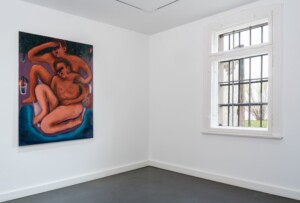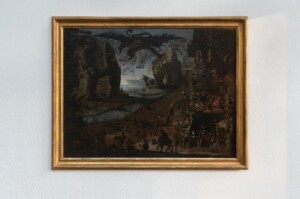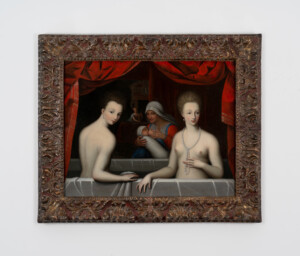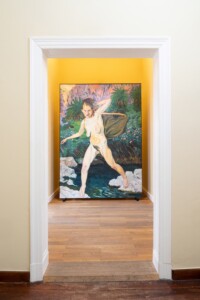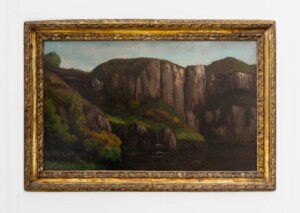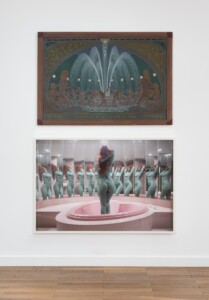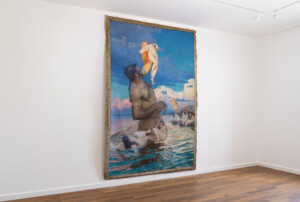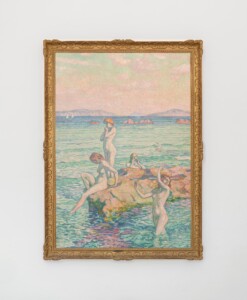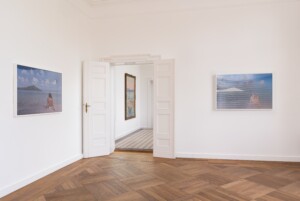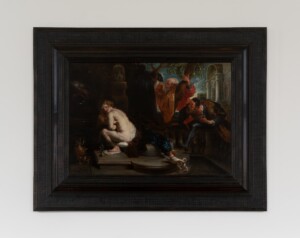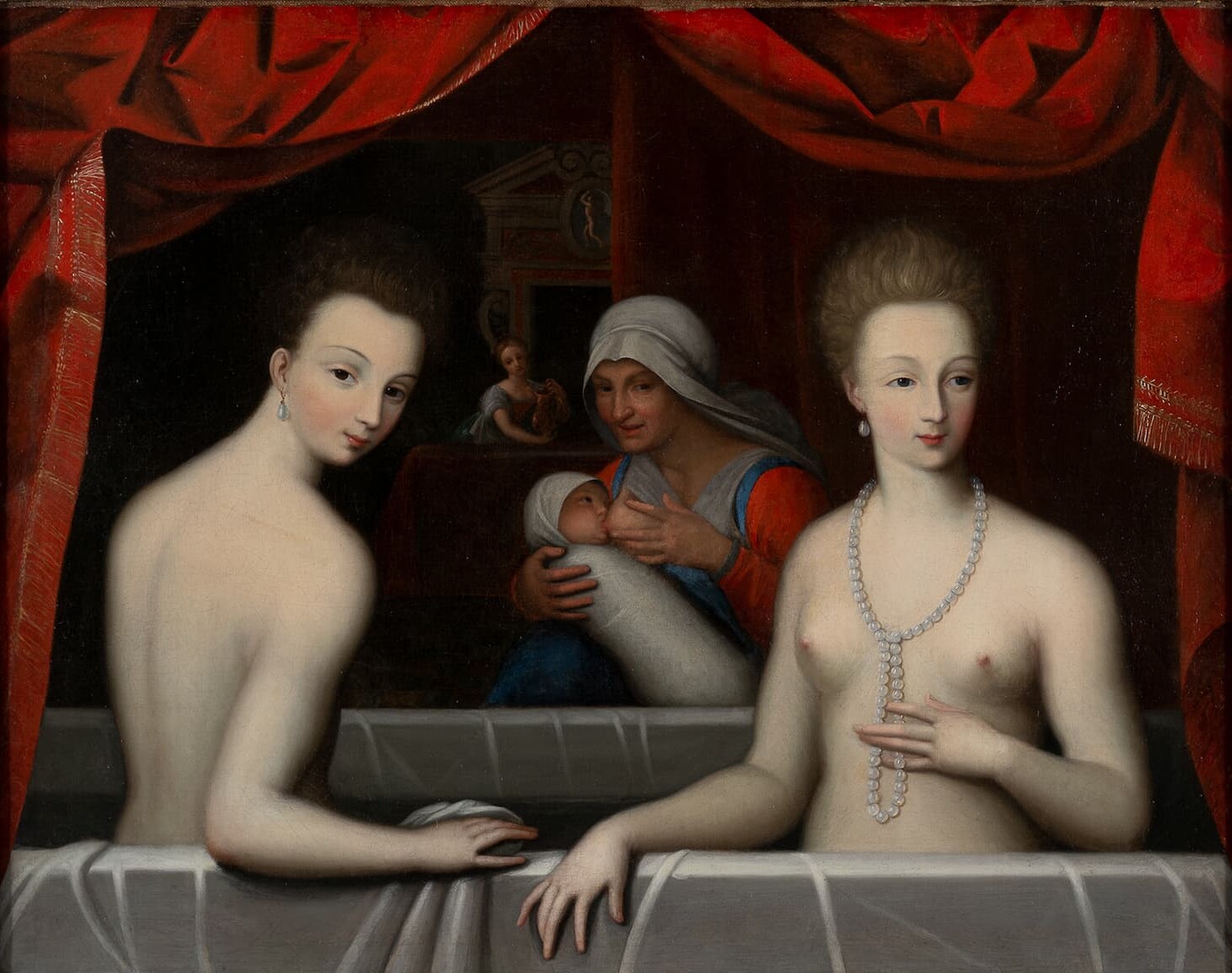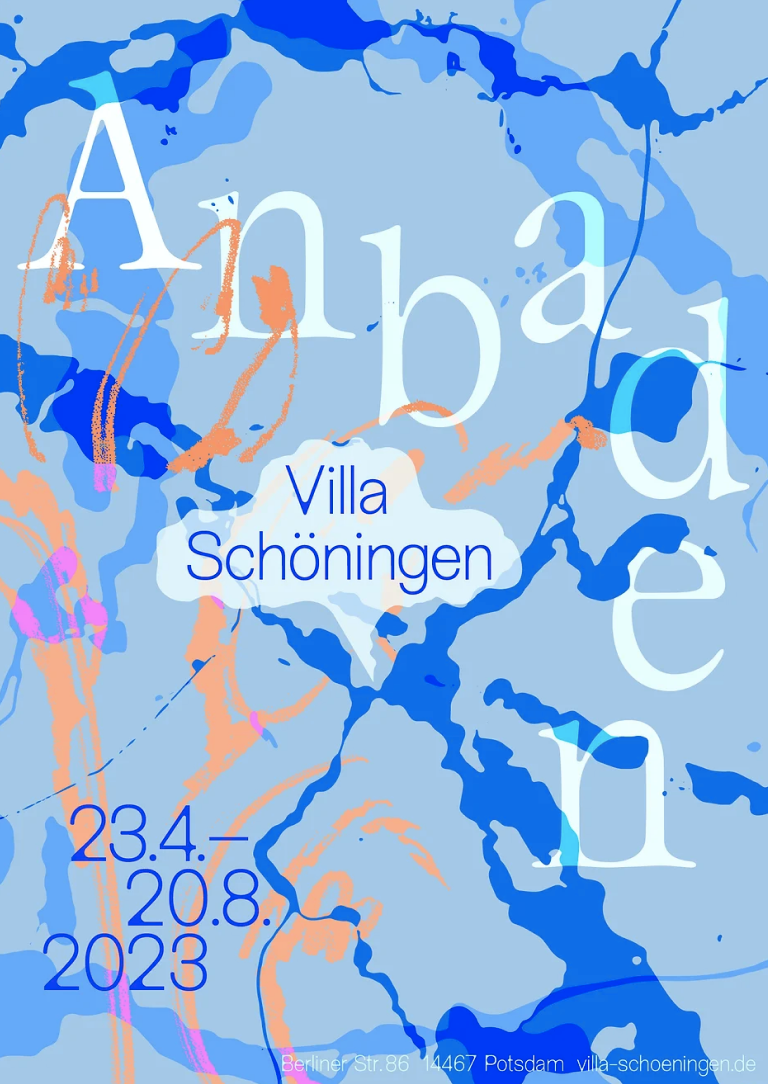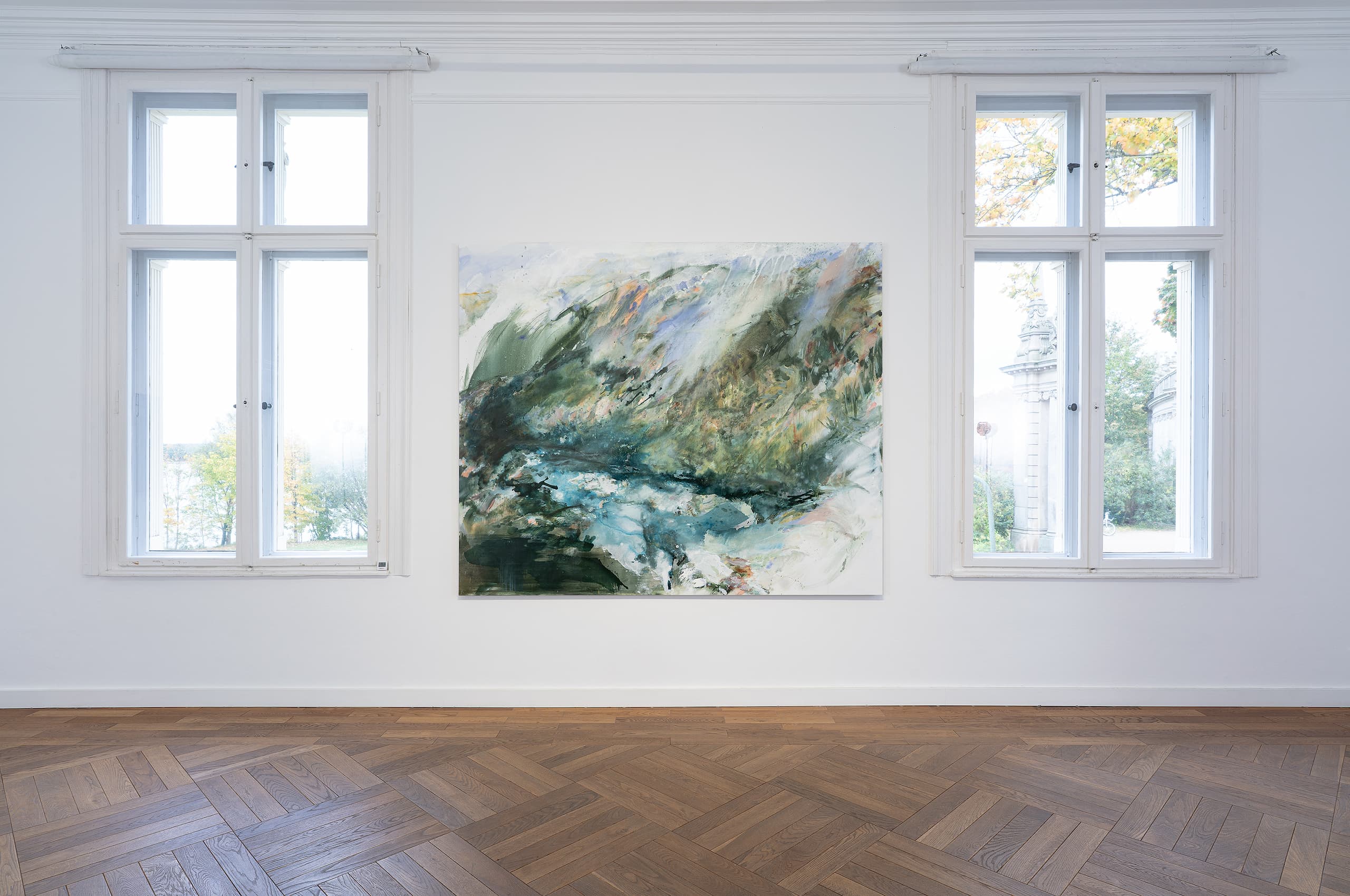Anbaden
The exhibition “Anbaden” presents a historical overview of the motif “Susanna at the Bath,” from classical masters such as Dürer, Rubens, and Renoir, to contemporary positions like Juno Calypso or Conny Maier. The long tradition of depicting the female nude in the context of water as a symbol of fertility is illuminated, while contemporary perspectives question the traditional gaze on the female body.
The exhibited work “Susanna and the Elders” by Rubens conveys the biblical story of Susanna bathing at a fountain and being observed by two priests. When they attempt to assault her, Susanna resists, but is then falsely accused of adultery, which was punishable at that time. It seems she can’t escape the patriarchal structures no matter what she does. Perhaps the first historical “MeToo” incident? As often seen in classical works, the painter directs the focus to the body. Susanna’s fair skin radiates amidst the dark background. While condemning the two elders, one becomes a voyeur themselves.
The relevance of the theme remains unbroken. The politically charged and sexually objectified treatment of the female body in society is evident in recent discussions about allowing women to swim without covering their breasts in Berlin public pools.
In Trulee Hall’s work “Hole in the Wall (After Étant Donnés)” from 2021, the figure seems to step out of the frame, transcending the assigned gaze. But how to deal with an image motif that mostly depicts white, idealized women as victims or culprits in the form of nymphs or other mythological figures?
All texts in the exhibition were authored by the language and text-based artificial intelligence Chat GPT, except for this one.
In 1970, the Japanese Masahiro Mori described the point at which artificial beings, as they approach human behavior, are no longer accepted as realistic by humans, known as the “Uncanny Valley.”
The contrast might seem enormous, combining historical paintings with texts generated by AI. Personal worldview vs. machine-created universality. But perhaps they still share something: an Uncanny Valley.
And the question remains: Must art and artificial intelligence be realistic?
 Pierre-Auguste Renoir, Baigneuse, 1876, Öl auf Leinwand, 36 x 28 cm © Villa Schöningen. Foto: Sascha Herrmann, 2023.
Pierre-Auguste Renoir, Baigneuse, 1876, Öl auf Leinwand, 36 x 28 cm © Villa Schöningen. Foto: Sascha Herrmann, 2023.
 Moriz Melzer, Fröhlicher Sommer (Sommerspiele), um 1911, Öl auf Leinwand, 106 x 101 cm, Pierre-Auguste Renoir, Baigneuse, 1876, Öl auf Leinwand, 36 x 28 cm © Villa Schöningen. Foto: Sascha Herrmann, 2023.
Moriz Melzer, Fröhlicher Sommer (Sommerspiele), um 1911, Öl auf Leinwand, 106 x 101 cm, Pierre-Auguste Renoir, Baigneuse, 1876, Öl auf Leinwand, 36 x 28 cm © Villa Schöningen. Foto: Sascha Herrmann, 2023.
 Conny Maier, Badende/ The newlyweds, 2019, Öl auf Leinwand, 150 x 110 cm © Conny Maier and Villa Schöningen.
Foto: Sascha Herrmann, 2023.
Conny Maier, Badende/ The newlyweds, 2019, Öl auf Leinwand, 150 x 110 cm © Conny Maier and Villa Schöningen.
Foto: Sascha Herrmann, 2023.
 Conny Maier, Badende/ The newlyweds, 2019, Öl auf Leinwand, 150 x 110 cm
Thomas Theodor Heine, Bad im Park, 1911, Öl auf Leinwand, 71,5 x 101,5 cm
© Conny Maier and Villa Schöningen.
Foto: Sascha Herrmann, 2023.
Conny Maier, Badende/ The newlyweds, 2019, Öl auf Leinwand, 150 x 110 cm
Thomas Theodor Heine, Bad im Park, 1911, Öl auf Leinwand, 71,5 x 101,5 cm
© Conny Maier and Villa Schöningen.
Foto: Sascha Herrmann, 2023.
 Cecily Brown, Untitled (Hylas and the Nymphs) #1/ Untitled (Hylas and the Nymphs) #2 2022, Archiv Pigmentdruck auf Fabriano Aquarellkarton, 45,8 x 60,9 cm
Jacob Isaacsz. van Swanenburg, zugeschrieben , Die Versuchung des Heiligen Antonius, ohne Jahresangabe, Öl auf Leinwand (doubliert), 89 x 118 cm
Conny Maier, Badende/ The newlyweds, 2019, Öl auf Leinwand, 150 x 110 cm © Cecily Brown, Conny Maier and Villa Schöningen.
Foto: Sascha Herrmann, 2023.
Cecily Brown, Untitled (Hylas and the Nymphs) #1/ Untitled (Hylas and the Nymphs) #2 2022, Archiv Pigmentdruck auf Fabriano Aquarellkarton, 45,8 x 60,9 cm
Jacob Isaacsz. van Swanenburg, zugeschrieben , Die Versuchung des Heiligen Antonius, ohne Jahresangabe, Öl auf Leinwand (doubliert), 89 x 118 cm
Conny Maier, Badende/ The newlyweds, 2019, Öl auf Leinwand, 150 x 110 cm © Cecily Brown, Conny Maier and Villa Schöningen.
Foto: Sascha Herrmann, 2023.
 Jacob Isaacsz. van Swanenburg, zugeschrieben, Die Versuchung des Heiligen Antonius, ohne Jahresangabe, Öl auf Leinwand (doubliert), 89 x 118 cm © Villa Schöningen.
Foto: Sascha Herrmann, 2023.
Jacob Isaacsz. van Swanenburg, zugeschrieben, Die Versuchung des Heiligen Antonius, ohne Jahresangabe, Öl auf Leinwand (doubliert), 89 x 118 cm © Villa Schöningen.
Foto: Sascha Herrmann, 2023.
 School of Fontainebleau, Gabrielle d’Estrées (1571–1599) at her bath with her sister, the Duchesse de Villars, um 1600, Öl auf Leinwand, 57,5 × 72,1 cm
© Villa Schöningen.
Foto: Sascha Herrmann, 2023.
School of Fontainebleau, Gabrielle d’Estrées (1571–1599) at her bath with her sister, the Duchesse de Villars, um 1600, Öl auf Leinwand, 57,5 × 72,1 cm
© Villa Schöningen.
Foto: Sascha Herrmann, 2023.
 Ana Mendieta, Untitled (Creek #2), 1974, Super-8 Film, digitalisiert
© Ana Mendieta and Villa Schöningen.
Foto: Sascha Herrmann, 2023.
Ana Mendieta, Untitled (Creek #2), 1974, Super-8 Film, digitalisiert
© Ana Mendieta and Villa Schöningen.
Foto: Sascha Herrmann, 2023.
 Johannes Grützke, Gesundheit, 1991, Öl auf Leinwand, 280 x 200 cm
© Joahnnes Grützke and Villa Schöningen.
Foto: Sascha Herrmann, 2023.
Johannes Grützke, Gesundheit, 1991, Öl auf Leinwand, 280 x 200 cm
© Joahnnes Grützke and Villa Schöningen.
Foto: Sascha Herrmann, 2023.
 Narcisse Díaz de la Peña, Badende Nymphen an einem Waldsee, ohne Jahresangabe, Öl auf Holz, 18 x 31,4 cm © Villa Schöningen.
Foto: Sascha Herrmann, 2023.
Narcisse Díaz de la Peña, Badende Nymphen an einem Waldsee, ohne Jahresangabe, Öl auf Holz, 18 x 31,4 cm © Villa Schöningen.
Foto: Sascha Herrmann, 2023.
 Carl Spitzweg, Grotte mit badenden Nymphen, 1855, Öl auf Papier, 22,2 x 19,3 cm © Villa Schöningen.
Foto: Sascha Herrmann, 2023.
Carl Spitzweg, Grotte mit badenden Nymphen, 1855, Öl auf Papier, 22,2 x 19,3 cm © Villa Schöningen.
Foto: Sascha Herrmann, 2023.
 Trulee Hall , Hole in the Wall (After Étant Donnés) , 2021, Acryl, Öl und Collage auf ehemaligem Hollywood Filmset, 183 x 192 cm
Karl Hofer, Sokotra, 1939, Öl auf Leinwand, 40 x 56 cm © Trulee Hall and Villa Schöningen.
Foto: Sascha Herrmann, 2023.
Trulee Hall , Hole in the Wall (After Étant Donnés) , 2021, Acryl, Öl und Collage auf ehemaligem Hollywood Filmset, 183 x 192 cm
Karl Hofer, Sokotra, 1939, Öl auf Leinwand, 40 x 56 cm © Trulee Hall and Villa Schöningen.
Foto: Sascha Herrmann, 2023.
 Gustave Courbet, Les rochers de Bonnevaux, 1866/1872, Öl auf Leinwand62 x 102 cm © Villa Schöningen.
Foto: Sascha Herrmann, 2023.
Gustave Courbet, Les rochers de Bonnevaux, 1866/1872, Öl auf Leinwand62 x 102 cm © Villa Schöningen.
Foto: Sascha Herrmann, 2023.
 Karl Hofer, Sokotra, 1939, Öl auf Leinwand, 40 x 56 cm Gustave Courbet, Les rochers de Bonnevaux, 1866/1872, Öl auf Leinwand, 62 x 102 cm © Villa Schöningen.
Foto: Sascha Herrmann, 2023.
Karl Hofer, Sokotra, 1939, Öl auf Leinwand, 40 x 56 cm Gustave Courbet, Les rochers de Bonnevaux, 1866/1872, Öl auf Leinwand, 62 x 102 cm © Villa Schöningen.
Foto: Sascha Herrmann, 2023.
 Max Pechstein, Morgen (Marta), 1932, Gouache auf leicht genarbtem Velin, 59,3 x 74,6 cm
Chris Ofili, Blue Siren, 2005, Holzschnitt auf Papier, 21,8 x 29,7 cm
Marcin Maciejowski, When you were eighteen, 2003, Öl auf Leinwand, 93 x 120 cm © Chris Ofili, Marcin Maciejowski and Villa Schöningen.
Foto: Sascha Herrmann, 2023.
Max Pechstein, Morgen (Marta), 1932, Gouache auf leicht genarbtem Velin, 59,3 x 74,6 cm
Chris Ofili, Blue Siren, 2005, Holzschnitt auf Papier, 21,8 x 29,7 cm
Marcin Maciejowski, When you were eighteen, 2003, Öl auf Leinwand, 93 x 120 cm © Chris Ofili, Marcin Maciejowski and Villa Schöningen.
Foto: Sascha Herrmann, 2023.
 Theodor Pixis, Das Rheingold, 1875, Öl auf Leinwand, 143 x 116 cm
© Villa Schöningen.
Foto: Sascha Herrmann, 2023.
Theodor Pixis, Das Rheingold, 1875, Öl auf Leinwand, 143 x 116 cm
© Villa Schöningen.
Foto: Sascha Herrmann, 2023.
 Fidus, Der strahlende Quell, 1897 + 1943, Öl auf Pappe, 91,7 x 137,8 cm
Juno Calypso, A Dream in Green from the Honeymoon Suite, 2015, Archivpigmentdruck, 105 x 156 cm
George Minne, Baigneuse IV, 1928, Gips, 37 x 15 x 12 cm
Lovis Corinth, Bacchantin, 1913, Öl auf Leinwand, 227 x 105 cm
Antike Amphoren, Anahita Sadighi Installation WOMAN LIFE FREEDOM, Kashan – Iran, 16.-19. Jahrhundert, Keramik, glasiert, verschiedene Größen John Roddam Spencer Stanhope, Andromeda , um 1870, Öl auf Leinwand, 130 x 54 cm © Juno Calypso and Villa Schöningen.
Foto: Sascha Herrmann, 2023.
Fidus, Der strahlende Quell, 1897 + 1943, Öl auf Pappe, 91,7 x 137,8 cm
Juno Calypso, A Dream in Green from the Honeymoon Suite, 2015, Archivpigmentdruck, 105 x 156 cm
George Minne, Baigneuse IV, 1928, Gips, 37 x 15 x 12 cm
Lovis Corinth, Bacchantin, 1913, Öl auf Leinwand, 227 x 105 cm
Antike Amphoren, Anahita Sadighi Installation WOMAN LIFE FREEDOM, Kashan – Iran, 16.-19. Jahrhundert, Keramik, glasiert, verschiedene Größen John Roddam Spencer Stanhope, Andromeda , um 1870, Öl auf Leinwand, 130 x 54 cm © Juno Calypso and Villa Schöningen.
Foto: Sascha Herrmann, 2023.
 John Roddam Spencer Stanhope, Andromeda , um 1870, Öl auf Leinwand, 130 x 54 cm Johann Rottenhammer, Perseus und Andromeda, 1613, Öl auf Holz, 40,5 x 29,3 cm Hans Rottenhammer (d.Ä.), Venus vor dem Bade, 1610/1620, Öl auf Schiefer, 22,7 x 16,2 cm © Villa Schöningen.
Foto: Sascha Herrmann, 2023.
John Roddam Spencer Stanhope, Andromeda , um 1870, Öl auf Leinwand, 130 x 54 cm Johann Rottenhammer, Perseus und Andromeda, 1613, Öl auf Holz, 40,5 x 29,3 cm Hans Rottenhammer (d.Ä.), Venus vor dem Bade, 1610/1620, Öl auf Schiefer, 22,7 x 16,2 cm © Villa Schöningen.
Foto: Sascha Herrmann, 2023.
 John Roddam Spencer Stanhope, Andromeda , um 1870, Öl auf Leinwand, 130 x 54 cm
Johann Rottenhammer, Perseus und Andromeda, 1613, Öl auf Holz, 40,5 x 29,3 cm Hans Rottenhammer (d.Ä.), Venus vor dem Bade, 1610/1620, Öl auf Schiefer, 22,7 x 16,2 cm
Georg Baselitz, Ade Nymphe I, 1998, Öl auf Leinwand, 103 x 162 cm
Albrecht Dürer, Das Meerwunder, um 1497/98, Kupferstich, 25,1 x 18,8 cm
Antike Amphoren, Anahita Sadighi Installation WOMAN LIFE FREEDOM, Kashan – Iran, 16.-19. Jahrhundert, Keramik, glasiert, verschiedene Größen © Georg Baselitz and Villa Schöningen.
Foto: Sascha Herrmann, 2023.
John Roddam Spencer Stanhope, Andromeda , um 1870, Öl auf Leinwand, 130 x 54 cm
Johann Rottenhammer, Perseus und Andromeda, 1613, Öl auf Holz, 40,5 x 29,3 cm Hans Rottenhammer (d.Ä.), Venus vor dem Bade, 1610/1620, Öl auf Schiefer, 22,7 x 16,2 cm
Georg Baselitz, Ade Nymphe I, 1998, Öl auf Leinwand, 103 x 162 cm
Albrecht Dürer, Das Meerwunder, um 1497/98, Kupferstich, 25,1 x 18,8 cm
Antike Amphoren, Anahita Sadighi Installation WOMAN LIFE FREEDOM, Kashan – Iran, 16.-19. Jahrhundert, Keramik, glasiert, verschiedene Größen © Georg Baselitz and Villa Schöningen.
Foto: Sascha Herrmann, 2023.
 Georg Baselitz, Ade Nymphe I, 1998, Öl auf Leinwand, 103 x 162 cm
Albrecht Dürer, Das Meerwunder, um 1497/98, Kupferstich, 25,1 x 18,8 cm
Bernardino Cesari, Tritonen und Satyrn rauben Nymphen , ohne Jahresangabe, Öl auf Holz, 76 x 62 cm Nicoló Bambini, Galatea, ohne Jahresangabe, Öl auf Leinwand, 146 x 190 cm Antike Amphoren, Anahita Sadighi Installation WOMAN LIFE FREEDOM, Kashan – Iran, 16.-19. Jahrhundert, Keramik, glasiert, verschiedene Größen © Georg Baselitz and Villa Schöningen.
Foto: Sascha Herrmann, 2023.
Georg Baselitz, Ade Nymphe I, 1998, Öl auf Leinwand, 103 x 162 cm
Albrecht Dürer, Das Meerwunder, um 1497/98, Kupferstich, 25,1 x 18,8 cm
Bernardino Cesari, Tritonen und Satyrn rauben Nymphen , ohne Jahresangabe, Öl auf Holz, 76 x 62 cm Nicoló Bambini, Galatea, ohne Jahresangabe, Öl auf Leinwand, 146 x 190 cm Antike Amphoren, Anahita Sadighi Installation WOMAN LIFE FREEDOM, Kashan – Iran, 16.-19. Jahrhundert, Keramik, glasiert, verschiedene Größen © Georg Baselitz and Villa Schöningen.
Foto: Sascha Herrmann, 2023.
 Georg Baselitz, Ade Nymphe I, 1998, Öl auf Leinwand, 103 x 162 cm
Albrecht Dürer, Das Meerwunder, um 1497/98, Kupferstich, 25,1 x 18,8 cm © Georg Baselitz and Villa Schöningen.
Foto: Sascha Herrmann, 2023.
Georg Baselitz, Ade Nymphe I, 1998, Öl auf Leinwand, 103 x 162 cm
Albrecht Dürer, Das Meerwunder, um 1497/98, Kupferstich, 25,1 x 18,8 cm © Georg Baselitz and Villa Schöningen.
Foto: Sascha Herrmann, 2023.
 Bernardino Cesari, Tritonen und Satyrn rauben Nymphen , ohne Jahresangabe, Öl auf Holz, 76 x 62 cm Nicoló Bambini, Galatea, ohne Jahresangabe, Öl auf Leinwand, 146 x 190 cm © Villa Schöningen.
Foto: Sascha Herrmann, 2023.
Bernardino Cesari, Tritonen und Satyrn rauben Nymphen , ohne Jahresangabe, Öl auf Holz, 76 x 62 cm Nicoló Bambini, Galatea, ohne Jahresangabe, Öl auf Leinwand, 146 x 190 cm © Villa Schöningen.
Foto: Sascha Herrmann, 2023.
 Fidus, Der strahlende Quell, 1897 + 1943, Öl auf Pappe, 91,7 x 137,8 cm
Juno Calypso, A Dream in Green from the Honeymoon Suite, 2015, Archivpigmentdruck, 105 x 156 cm © Juno Calypso and Villa Schöningen.
Foto: Sascha Herrmann, 2023.
Fidus, Der strahlende Quell, 1897 + 1943, Öl auf Pappe, 91,7 x 137,8 cm
Juno Calypso, A Dream in Green from the Honeymoon Suite, 2015, Archivpigmentdruck, 105 x 156 cm © Juno Calypso and Villa Schöningen.
Foto: Sascha Herrmann, 2023.
 Hans Rottenhammer (d.Ä.), Venus vor dem Bade, 1610/1620, Öl auf Schiefer, 22,7 x 16,2 cm © Villa Schöningen.
Foto: Sascha Herrmann, 2023.
Hans Rottenhammer (d.Ä.), Venus vor dem Bade, 1610/1620, Öl auf Schiefer, 22,7 x 16,2 cm © Villa Schöningen.
Foto: Sascha Herrmann, 2023.
 Max Pietschmann, Fischzug des Polyphem, 1892
Öl auf Leinwand, 380 x 260 cm © Villa Schöningen.
Foto: Sascha Herrmann, 2023.
Max Pietschmann, Fischzug des Polyphem, 1892
Öl auf Leinwand, 380 x 260 cm © Villa Schöningen.
Foto: Sascha Herrmann, 2023.
 Max Pietschmann, Konvolut Fotos und Varia, Historische Fotografien und Skizzen, um1891, verschiedene Größen Max Pietschmann, Studie zum Fischzug des Polyphem, 1891, Öl auf Leinwand, 74,5 x 115 cm
© Villa Schöningen.
Foto: Sascha Herrmann, 2023.
Max Pietschmann, Konvolut Fotos und Varia, Historische Fotografien und Skizzen, um1891, verschiedene Größen Max Pietschmann, Studie zum Fischzug des Polyphem, 1891, Öl auf Leinwand, 74,5 x 115 cm
© Villa Schöningen.
Foto: Sascha Herrmann, 2023.
 Max Pietschmann, Studie zum Fischzug des Polyphem, 1891, Öl auf Leinwand, 74,5 x 115 cm
Max Pietschmann, Konvolut Fotos und Varia, Historische Fotografien und Skizzen, um 1891, verschiedene Größen
© Villa Schöningen.
Foto: Sascha Herrmann, 2023.
Max Pietschmann, Studie zum Fischzug des Polyphem, 1891, Öl auf Leinwand, 74,5 x 115 cm
Max Pietschmann, Konvolut Fotos und Varia, Historische Fotografien und Skizzen, um 1891, verschiedene Größen
© Villa Schöningen.
Foto: Sascha Herrmann, 2023.
 Nicholas Warburg, DIE OBEREN 10.000, 2020, 100 DM Schein Handtuch-Stapel Meißen, Modell R. Ockelmann, Nach dem Bade, 1883 , Porzellan, farbig und gold staffiert, Höhe 45 cm Constant Dullaart , Jennifer in Paradise , 2014/2015, Lentikulardruck, Je 79 x 119 cm
© Nicholas Warburg und Villa Schöningen.
Foto: Sascha Herrmann, 2023.
Nicholas Warburg, DIE OBEREN 10.000, 2020, 100 DM Schein Handtuch-Stapel Meißen, Modell R. Ockelmann, Nach dem Bade, 1883 , Porzellan, farbig und gold staffiert, Höhe 45 cm Constant Dullaart , Jennifer in Paradise , 2014/2015, Lentikulardruck, Je 79 x 119 cm
© Nicholas Warburg und Villa Schöningen.
Foto: Sascha Herrmann, 2023.
 Meißen, Modell R. Ockelmann, Nach dem Bade, 1883 , Porzellan, farbig und gold staffiert, Höhe 45 cm
Constant Dullaart , Jennifer in Paradise , 2014/2015, Lentikulardruck, Je 79 x 119 cm
© Constant Dullaart and Villa Schöningen.
Foto: Sascha Herrmann, 2023.
Meißen, Modell R. Ockelmann, Nach dem Bade, 1883 , Porzellan, farbig und gold staffiert, Höhe 45 cm
Constant Dullaart , Jennifer in Paradise , 2014/2015, Lentikulardruck, Je 79 x 119 cm
© Constant Dullaart and Villa Schöningen.
Foto: Sascha Herrmann, 2023.
 Theo van Rysselberghe, Baigneuses autour d’un rocher (Baigneuses sur les rochers), 1910
Öl auf Leinwand, 163 x 113 cm © Villa Schöningen.
Foto: Sascha Herrmann, 2023.
Theo van Rysselberghe, Baigneuses autour d’un rocher (Baigneuses sur les rochers), 1910
Öl auf Leinwand, 163 x 113 cm © Villa Schöningen.
Foto: Sascha Herrmann, 2023.
 Massimo Stanzione, Susanna und die beiden Alten, um, Öl auf Leinwand, 146 x 175 cm Constant Dullaart , Jennifer in Paradise , 2014/2015, Lentikulardruck, Je 79 x 119 cm © Constant Dullaart and Villa Schöningen.
Foto: Sascha Herrmann, 2023.
Massimo Stanzione, Susanna und die beiden Alten, um, Öl auf Leinwand, 146 x 175 cm Constant Dullaart , Jennifer in Paradise , 2014/2015, Lentikulardruck, Je 79 x 119 cm © Constant Dullaart and Villa Schöningen.
Foto: Sascha Herrmann, 2023.
 Peter Paul Rubens (Werkstatt), Susanna und die Alten, ohne Jahresangabe, Öl auf Holz, 50 x 71,5 cm
Constant Dullaart , Jennifer in Paradise , 2014/2015, Lentikulardruck, Je 79 x 119 cm
Theo van Rysselberghe, Baigneuses autour d’un rocher (Baigneuses sur les rochers), 1910
Öl auf Leinwand, 163 x 113 cm © Constant Dullaart und Villa Schöningen.
Foto: Sascha Herrmann, 2023.
Peter Paul Rubens (Werkstatt), Susanna und die Alten, ohne Jahresangabe, Öl auf Holz, 50 x 71,5 cm
Constant Dullaart , Jennifer in Paradise , 2014/2015, Lentikulardruck, Je 79 x 119 cm
Theo van Rysselberghe, Baigneuses autour d’un rocher (Baigneuses sur les rochers), 1910
Öl auf Leinwand, 163 x 113 cm © Constant Dullaart und Villa Schöningen.
Foto: Sascha Herrmann, 2023.
 Constant Dullaart , Jennifer in Paradise , 2014/2015, Lentikulardruck, Je 79 x 119 cm
Theo van Rysselberghe, Baigneuses autour d’un rocher (Baigneuses sur les rochers), 1910
Öl auf Leinwand, 163 x 113 cm © Constant Dullaart und Villa Schöningen.
Foto: Sascha Herrmann, 2023.
Constant Dullaart , Jennifer in Paradise , 2014/2015, Lentikulardruck, Je 79 x 119 cm
Theo van Rysselberghe, Baigneuses autour d’un rocher (Baigneuses sur les rochers), 1910
Öl auf Leinwand, 163 x 113 cm © Constant Dullaart und Villa Schöningen.
Foto: Sascha Herrmann, 2023.
 Peter Paul Rubens (Werkstatt), Susanna und die Alten, ohne Jahresangabe, Öl auf Holz, 50 x 71,5 cm © Villa Schöningen.
Foto: Sascha Herrmann, 2023.
Peter Paul Rubens (Werkstatt), Susanna und die Alten, ohne Jahresangabe, Öl auf Holz, 50 x 71,5 cm © Villa Schöningen.
Foto: Sascha Herrmann, 2023.
 Massimo Stanzione, Susanna und die beiden Alten, um, Öl auf Leinwand, 146 x 175 cm © Villa Schöningen.
Foto: Sascha Herrmann, 2023.
Massimo Stanzione, Susanna und die beiden Alten, um, Öl auf Leinwand, 146 x 175 cm © Villa Schöningen.
Foto: Sascha Herrmann, 2023.


